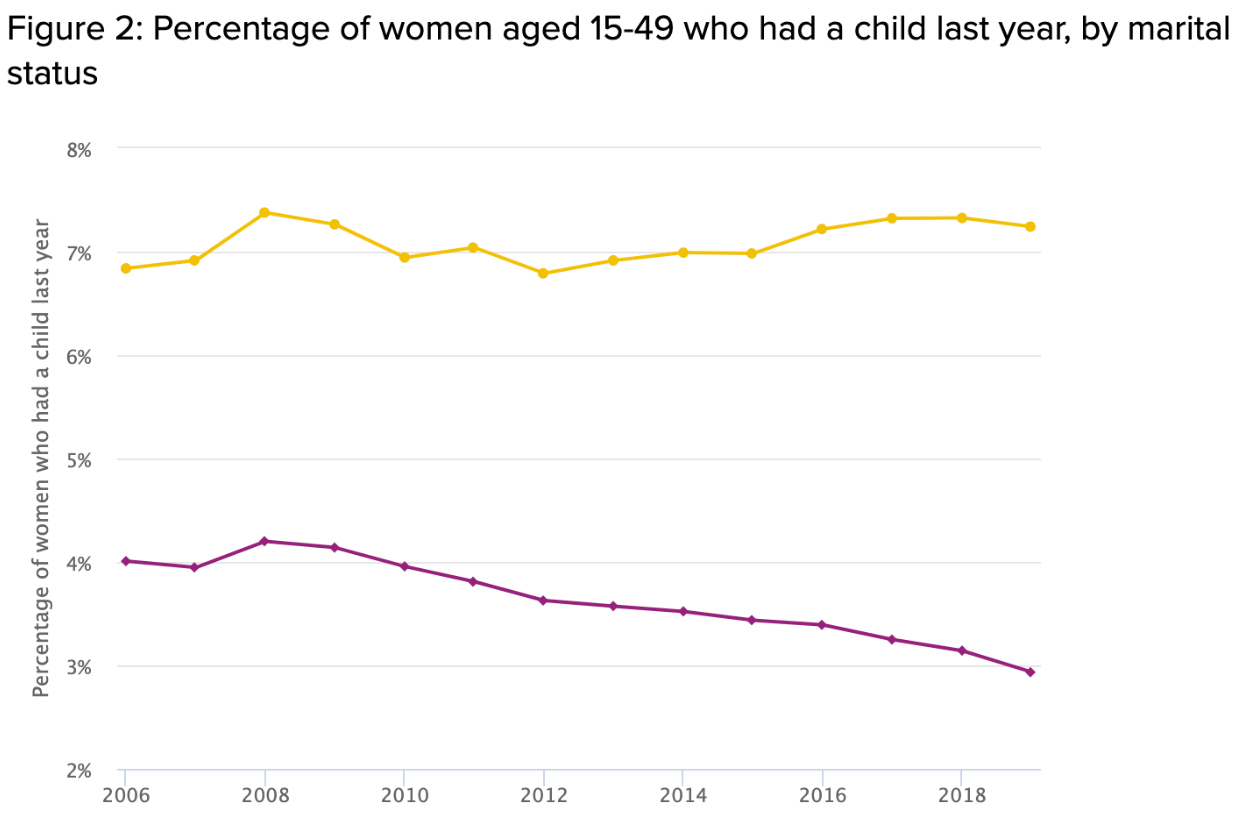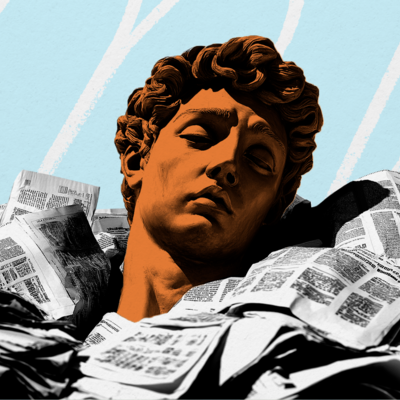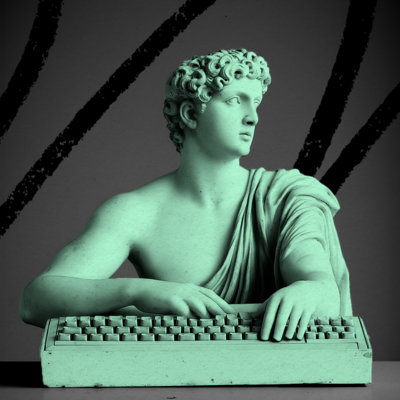
Young single people are experiencing widespread fatigue from dating apps—so much so that Tinder’s CMO recently opined that people need to put their phones down in social situations. So we thought it was an opportune time to republish this piece about Tinder by Evan Armstrong, who explains how the ubiquitous app plays a key role in the U.S. economy by facilitating population growth. Fittingly, Evan is practicing what he preaches: In the piece, he also writes about meeting his wife on Hinge. The two are currently away on their babymoon.—Kate Lee
Was this newsletter forwarded to you? Sign up to get it in your inbox.
Jimi Hendrix had his Fender Stratocaster. Yo-Yo Ma, his Stradivarius. Steve, your lovable dumbass neighbor from college? He has Tinder. The match of his bronzer-lotioned finger with Tinder’s devilishly swipeable surface is the ultimate pairing of tool and tool. It is a symbiotic relationship—in exchange for dollars, Tinder provides, as Steve so elegantly calls them, “babes.”
However, Steve has a secret: a deep, all-consuming love for the opera. In his pursuit of the perfect babe, Steve is looking for someone who will share his affinity for crying to Pavarotti and crushing White Claws. Normally, he might have issues finding such an individual during rush week. But with Tinder’s AI-powered algorithms, the alto-alcoholic of his dreams is just one finger flick away.
So why does Tinder matter? Because it facilitates love and, by extension, grows the world’s population.
Many technologists want to work at mission-driven companies, to make a difference in the world. To do so, they duct-tape together bits and atoms into a shape that produces net-new economic activity. When you look to change the world, you may think of frontier sciences: nuclear fusion or space flight or large language models. I do not deny that these things are objectively cool. However, I would argue there is someone with a greater, more immediate need for help from our most brilliant minds. That person is Steve.
I will also admit to having once been in a similar situation as our operatic frat bro. In 2020, my love life was a disaster, and I couldn’t find anyone I really clicked with. Then, one day on Hinge (a dating app owned by Match Group, the same parent company that owns Tinder), I received a “most compatible” recommendation from their AI algorithm, and there on my screen was Morgan. We had no mutual friends, no overlap in our interests, and, to the casual observer, nothing in common. She is an academic who studies English literature, and, well, I’m a nerd who likes startups.
But somehow, Hinge’s algorithm knew we would get along. Our first date went for three times as long as we planned. Our second date was supposed to be an hour—it ended up being six. A little over a year after meeting, we were married. The best thing that ever happened to me was only possible because of a recommendation algorithm. An underappreciated fact about dating apps is that they pierce social circles. You meet people you might have never met normally, and I just happened to meet my soulmate.
Love lifts us up where we belong…is the purpose for living…all that Hallmark-branded hullabaloo. Theoretically, I could end my argument right here. But this column is Napkin Math, and so we have to talk about the real reason love matters: It makes the economy work. And the reason why is simple.
We need more babies.
The economic importance of finding love
I cannot overstate how critical it is to have a young labor force.
Almost every Nobel Prize has been awarded to researchers who made discoveries between the ages of 31–40 (41.8 percent and 47.4 percent, correspondingly). Young people make pension insurance programs like Social Security possible by paying into the deposit base. Old people rely upon a ton of federal resources—the U.S. government currently spends 40 percent of its budget on people 65 and up. Young people are a malleable workforce that can be funneled toward where opportunity is.
When a country goes below population-replacement levels, there are ever more elderly supported by ever fewer young people. Countries such as Italy and Japan have already seen flagging economies from decreased birth rates. Rural towns slowly die as young populations consolidate around urban centers. To try to prevent similar problems, South Korea has spent over $150 billion to encourage families to have more kids. But this spending has made no material difference.
Theoretically, you could fix these concerns caused by shrinking populations by:
- enabling the elderly to work for longer and be healthier for more years, or
- decreasing the level of government support to the elderly.
The first option feels very distant, and the second option feels deeply cruel. The best remaining option is probably to make more babies. There are environmental concerns that increased populations bring, but we have to make the bet that technologies like fusion or fertilizer will allow us to keep up with the power and food requirements of a growing planet.
In other words, America is screwed until we figure out how to screw again.
Where is the problem?
Fertility has rapidly decreased in the Western world. In the U.S., the total fertility rate (TFR) was 2.2 births per woman in 2008. By 2019, the rate sagged to 1.7 per woman in 2019. This dip below population-replacement levels means that, when coupled with America’s collapsing immigration rates, the country’s population will begin to decrease. This is bad for reasons we will discuss momentarily.
With closer examination of TFR, something really fascinating emerges: Fertility rates in total are going down, but not among married women. If you’re married, you’re having the same number of babies as before (that’s the yellow line in the graph below). Fertility rates are going down, but the fertility rates of married people are pretty much the same. (The purple line represents the fertility rate among single women.)
Source: University of Pennsylvania
The Only Subscription
You Need to
Stay at the
Edge of AI
The essential toolkit for those shaping the future
"This might be the best value you
can get from an AI subscription."
- Jay S.
Join 100,000+ leaders, builders, and innovators

Email address
Already have an account? Sign in
What is included in a subscription?
Daily insights from AI pioneers + early access to powerful AI tools










Comments
Don't have an account? Sign up!
I am deeply tired of the argument that a replacement birth rate is a necessity. No one asked us, the people being expected to just have kids, when they decided to have 10 kids per couple and exponentially increase the population. It’s a temporary problem. The population will shrink and housing, food, etc. will become more affordable. The economy will be fine. Nothing is meant to grow infinitely and it is a ridiculous idea that the economy is an exception to that rule.
Loved the article! The only (potential) nitpick is the couples math. If 2 million people get into a relationship, wouldn't that result in 1 million couples (to have babies)? And if so, then Match Group would be conservatively responsible for 250,000 couples (vs. 500,000). And that cost per baby factory would increase to $7,200 (vs. $3,600). Even if I'm right, your point still stands. I just wanted to make sure I'm not going crazy. Thanks again for the great read!
@bjones1831 Good nitpick! This is very, very handwavy math. Depends on how much of the online relationships/marriages you give them credit for. My assumptions gave them a little more than yours did. I just tried to be conservative with it. (my gut tells me that this number of "meet online" is actually much higher because of social stigma so you could argue that my number was actually too conservative!)
@ItsUrBoyEvan ugh typo and we haven't made an edit feature in the CMS lol. *my number wasn't actually conservative enough*
@ItsUrBoyEvan hahaha. i read it as such (CMS edits be damned).... and i'm with you on the social stigma angle. That 55% figure is probably the absolute floor.
Or maybe, just maybe... Capitalism can't solve *every* problem. Frankly it's no surprise to me that such a deeply human and emotionally-driven thing as romance (and sex) is problematic for facilitation through economic means and incentives. Capitalism has no effective methods of reliably incorporating human wellbeing in its calculus, so when it comes to things where human emotions and experiences matter very deeply (romance, health care, some other sorta important things), it tends to fail pretty miserably. As a booster of the startup and general company-driven approach to solving problems I get that this is your best answer, but this really seems like a "every problem looks like a nail if you own a hammer" situation to me. What *other* ways could we solve this that don't rely on trying to wring some tortured version of aligned incentives out of the situation?